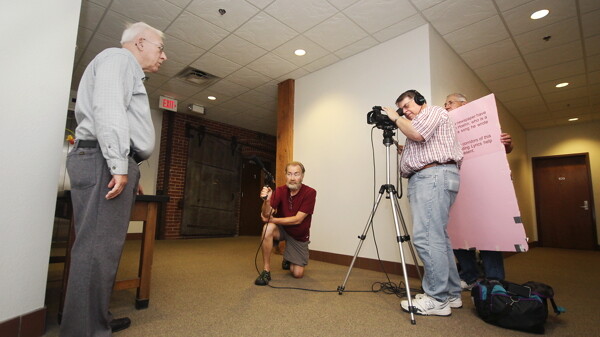Filming Uniroyal
locally made Uniroyal documentary in the works
Kinzy Janssen, photos by Andrea Paulseth |

It has been 20 years since the hulking brick building on the horizon above the Eau Claire River hosted the smell of lampblack – a key ingredient, I learned, in tire manufacturing. Both the term and the industry are foreign to me, a fact not lost on Dennis R. Miller, former maintenance electrician at the company and recent documentary filmmaker. In fact, his idea to create a documentary film about the old Uniroyal plant found traction after Miller was met with a blank stare at the mention of the once-household name. Indeed, Uniroyal Goodrich Tire Company boosted Eau Claire wages among the highest in the state and sustained 1,358 separate livelihoods about a year before it closed permanently in 1992.
“The tire plant was probably even more important than the logging industry,” Miller says, noting that Eau Claire already has the Paul Bunyan Logging Museum to acknowledge that epoch – thus the necessity of the documentary, Voices from the Past, a Virtual Tour of Eau Claire’s Tire Museum.
“The tire plant was probably even more important than
the logging industry.” – former Uniroyal worker and recent documentary filmmaker
Dennis R. Miller
Since October 2011, Miller has been spearheading the research, writing the scripts for the narrators and living actors, directing the filming, and producing Voices from the Past.
The film, which exists in unedited long form and has yet to be cut-and-spliced by both My Town Pictures and Miller himself, is indeed a virtual museum. With the help of a group of volunteers, Miller gleaned artifacts from the Chippewa Valley Museum and displayed them in “Galleries” in Banbury Place and elsewhere. As the camera pans through the galleries, the objects give a sense of the physical history of the plant, and the space itself emits visual echoes. “You can sense the age of the place,” he says.
The six galleries also serve as different thematic chunks for the film – from Union Hall to the Plant Closing, with a separate introduction by Judy Clark where she invites viewers to “punch in.” (Miller was able to acquire an authentic time clock for the shot). Miller punctuates the “still life” approach with actors portraying real people – the “living history” element of the project. “[These] take place in the twilight of the factory’s history. But [the actors] may be dressed like they’re in the 1930’s,” says Miller, who took care to examine every episode of the plant’s history and was able to borrow costumes from the Chippewa Valley Theatre Guild.
The third style of footage Miller incorporates is old film from inside the tire plant’s operative days.
This isn’t Miller’s first foray into capturing the past through media. He wrote a book called America’s Heartbeat in 1992, shortly after transferring to the Tuscaloosa plant (where he worked for seven years following 15 years in Eau Claire) that he says was largely fueled by emotion. “This is different,” he says of Voices from the Past. “Twenty years later, I was able to look at it with a softer filter... and film is more powerful. If a picture is worth a thousand words, you put the pictures together into a film and it’s even more powerful.”
Throughout his research, Miller learned about what happened at the plant before he worked there. The foundation for the rubber company was laid in 1915, and the first tire rolled off the line in 1917 under the ownership of Gillette Safety Tires. But the factory’s proper heyday happened after WWII when the United States Rubber Company bought it and invested $20 million in the plant to “make it the most modern tire plant in the world,” according to Miller. Apparently, even Coca Cola took note, and “gave it a salute” (honored the plant) by sponsoring Gene Krupa and his Orchestra, a particularly famous group during that period, to play a show in Eau Claire.
Though that seems rather endearing nowadays, the successes of the company were real and far-reaching. “It made it a wonderful place to live. Because of the high wage we were able to send our children back then to college to fulfill the American dream, whatever was in their hearts,” Miller says.
His hope is that the history portrayed on the DVD will inspire locals to support a real museum. A generous, idea-filled person who aims to change people through knowledge, Miller will be donating all proceeds from sales and a November State Theater screening to the jail ministry, Grace Aftercare, and Tears of Love ministry (his own organization).






















